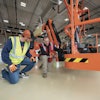![800px Saw Cut Control Joint In Concrete 5ebabe3babfac[1]](https://img.forconstructionpros.com/files/base/acbm/fcp/image/2020/12/800px_Saw_Cut_Control_Joint_in_Concrete.5ebabe3babfac_1_.5fd137cdacba6.5fd137deebf6d.png?auto=format%2Ccompress&q=70&rect=0%2C151%2C800%2C450&w=400)
From contraction joints to robots, from a nuclear power plant to thermal breaks, our audience found a wide range of content within the /concrete section of the ForConstructionPros.com website.
Here are the most popular stories from November 2020 be they news, announcements, releases, or articles.
By Page View
Rules for Designing Contraction Joints
Through their experience in concrete, longtime contributor Kim Basham provides ten rules in the layout, spacing, depth, and timing of contraction joints. For either a wet-cut saw or an early-entry dry-cut saw, follow these jointing rules to minimize the risk of random or out-of-joint cracking.
Watch Time-Lapse Video of Final Concrete Pour at Hinkley Point C Reactor
 Final section of the 20,693 m3 of concrete being poured into the foundation of Hinkley Point C Unit 2's Nuclear Island.EDF
Final section of the 20,693 m3 of concrete being poured into the foundation of Hinkley Point C Unit 2's Nuclear Island.EDF
The four pumps seem like spider legs while in fast-forward. Refill your coffee and check this video out.
Adding Calcium Chloride to Improve Cold Weather Concrete Pouring
Two questions: can you use calcium chloride admixtures? And, if so, what is an acceptable dosage? This article going through both using the International Building Code as a guideline.
Spoiler: Yes, and about 2% by weight of cement.
But you need to get that confirmed.
It’s Only Just Begun: Miami’s $25 Million Underground Parking Garage
 Engineers are using a state-of-the-art, 10-foot high-torque drill to create the bathtub by digging into the site’s crushed limestone, while simultaneously injecting cement slurry into the ground and blending it with the limestone rock and sand.OKO Group/Cain International
Engineers are using a state-of-the-art, 10-foot high-torque drill to create the bathtub by digging into the site’s crushed limestone, while simultaneously injecting cement slurry into the ground and blending it with the limestone rock and sand.OKO Group/Cain International
Find more details on the project, challenges, and specs in the story.
AI Robot Can Flatten Concrete Floors, Hyundai Engineering Seeks Patent
While the robot is still under the manufacturing stage with a prototype, news of a technology from Hyundai Engineering that could help flatten floors is exciting – to say the least. On Nov. 12, the company started filing for patents.
We reached out for more information and will report as they come in ... stay tuned.
By Average Time
A Museum and Theater for the Motion Picture Industry
Imagine building a structural concrete sphere 150 ft. in diameter weighing 25 million pounds (25,000 kips) held in position 12 ft. off the ground by four concrete columns with seismic isolators between the columns and the sphere.
Joe Nasvik writes about the design and engineering that went into the Academy Museum of Motion Pictures in LA.
 The inventory screen provided here shows how tools and equipment are logged into their cloud website and managed. Milwaukee is the only company that also allows their tools factory settings to be changed with a smartphone app to increase operating efficiency for given applications.Milwaukee Tool
The inventory screen provided here shows how tools and equipment are logged into their cloud website and managed. Milwaukee is the only company that also allows their tools factory settings to be changed with a smartphone app to increase operating efficiency for given applications.Milwaukee Tool
This article from 2018 looks at some offerings from Bosch, Hilti, and Milwaukee Tool in asset management.
This is the story of the design, engineering, and construction of Chicago’s Vista Tower. The 100-story building stands at 1,190 feet above the ground – the city’s third tallest building behind Willis Tower and the Trump Tower.
The vision began with discussions between Magellan Development and Jeannie Gang at Studio Gang Architecture. Then Ron Klemencic, the CEO of Magnusson Klemenscic Associates (MKA) based in Seattle, Washington was brought in to help make their concept structurally and economically viable. Klemencic involved McHugh Construction and others to bring together the latest research and technology and up-to-date construction practices.
 Thermal cracking is usually associated with mass concrete but it can also happen to thinner slabs because of temperature differences between concrete ground, and ambient temperatures.John Gajda
Thermal cracking is usually associated with mass concrete but it can also happen to thinner slabs because of temperature differences between concrete ground, and ambient temperatures.John Gajda
This article talks about some of the conditions that can cause this to occur. And conditions you should be aware of and plan for.
Thermal Breaks Provide Energy Efficiency in Concrete Reinforced Condo
The 30,000 sq. ft., the seven-story structure offers nine two-, three- and four-bedroom luxury loft residences from 1,545 to 3,400 sq. ft. The units feature high ceilings, cantilevered balconies, open floor plans, oversized windows, state-of-the-art kitchens, and master suites with walk-in closets. Some enjoy panoramic views of the Manhattan skyline.
Tracy Dacko, head of marketing for Schock North America writes of this project.




















